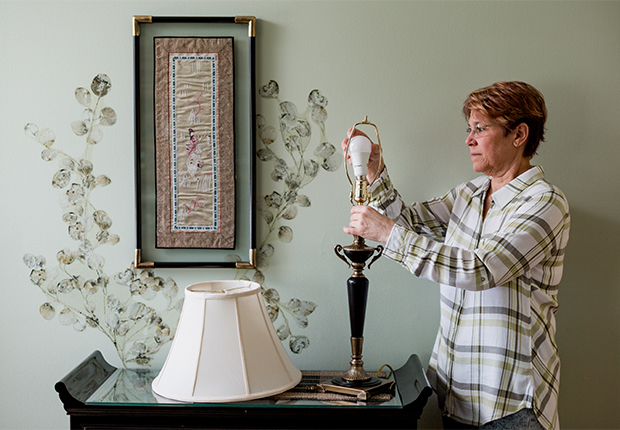AARP Hearing Center

By Melissa Preddy
Cindy Karagosian recently upgraded to LED light bulbs throughout her three-bedroom ranch house and has been swapping energy conservation tips with friends. But the ninth-grade English teacher from Independence Township figures she could do more to trim her electric bill—she just isn’t sure where to start.
The average monthly household electric tab in Michigan was $93.61 in 2015, according to the latest figures from the federal Energy Information Administration. That’s up from $58.99 a decade earlier.
Michigan residents pay an average of 15.3 cents per kilowatt hour (kwh), compared to 12.5 cents nationally.
“You see all of these cost-saving ideas on TV, but I don’t know how to apply them to my own home,” said Karagosian, 58. “I want to say, ‘Walk me through it, will ya?’ ”
Helping consumers understand and manage their electricity usage—and bills—is the aim of a pilot workshop being designed by AARP Michigan in partnership with DTE Energy, parent company of the state’s largest electric utility.
Starting in Detroit in September, seminars will raise awareness of money-saving programs, help attendees read their statements, and outline the pros and pitfalls of signing up for emerging demand-based rate schemes.
“People might not realize the control they have over how much power they use and what they pay for it,” said Robert Kaslik, AARP Michigan’s lead volunteer on energy issues. “The utilities want to educate their customers and we want to be part of that process.”
New smart meters put hour-by-hour usage data at the fingertips of energy providers and consumers, Kaslik noted. The ability to analyze and predict periods of high or low demand in such detail lets power companies reward households willing to trim usage at crucial times, such as hot summer days.
AARP Michigan leaders say the time is ripe to focus on the dual goals of cost savings and conservation.
Providers are eager to cooperate in consumer education efforts to reduce waste and curb the need for costly new power plants. And a spurt of technological changes, from newer light bulbs to intelligent appliances that can be set to wash clothes or dishes in the wee hours, are increasing consumers’ options—and confusion.
For example, utilities have long offered lower-cost interruptible air-conditioning service, which puts the AC on a separate meter so it can be cycled off periodically during peak demand.
Now, various rate options provide additional incentives for consumers to trim usage at crucial times, such as hot summer days. Running equipment late at night, for example, costs less than the peak daytime rate.
Doing so led to an average savings of about 10 percent for a pilot program’s participants, said Julie Maher, manager of energy efficiency for DTE Energy. That could mean a savings of more than $100 a year.
Maher also noted that DTE offers other free tools, which likely will be highlighted in the AARP-DTE workshops, such as a free smartphone app and in-house monitor that show customers their real time usage.
“You can even hold your iPhone over a power cord and see how much power an individual appliance is drawing,” said Maher.
The downside is that costs can soar if consumers use lots of energy during the hours of critical hot-weather demand, said Melissa Seifert, AARP Michigan associate state director.
The energy seminars also will highlight senior discounts, home energy audits, rebate programs and other dollar-saving ideas.
“Our hope is that this will become a partnership between AARP and utilities throughout the country,” Seifert said. More information about the AARP-DTE seminars will be posted at aarp.org/mi.
Melissa Preddy is a writer living in Plymouth, Mich.































































